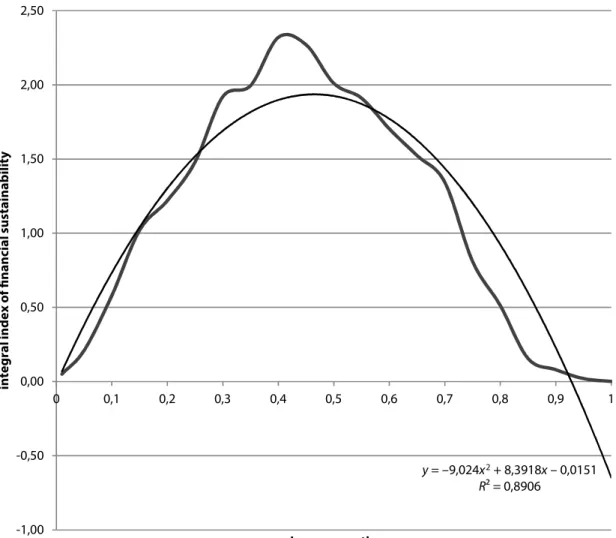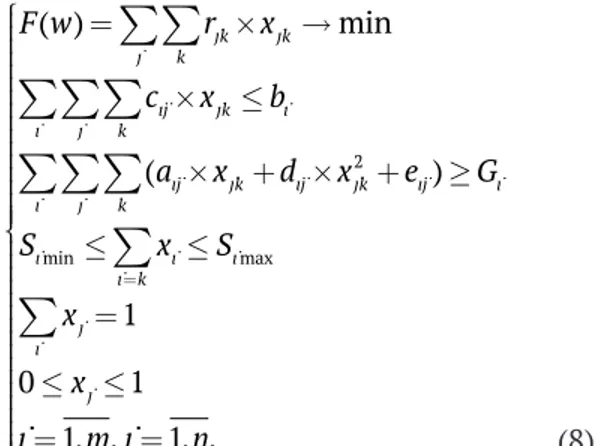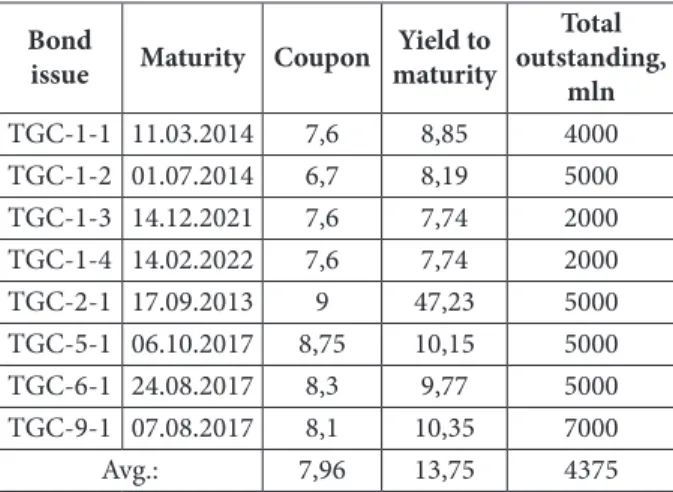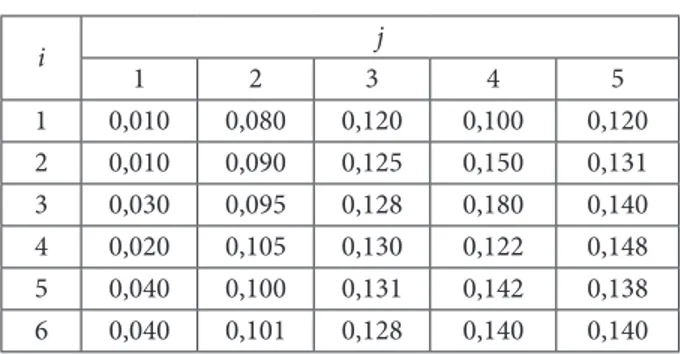Information about the author
Yu. Domnikov, M. J. Khodorovsky, P. M. Khomenko
OPTIMIZATION OF FINANCES INTO REGIONAL ENERGY
1The development of modern Russian energy collides with the need for major investments in the modern -ization and renewal of generation and transmission capacity. In terms of attracting suficient inancial re -sources and ind ways to increase, energy sector proitability and investment attractiveness of particular im -portance is the problem of investment inancing optimizing aimed at minimizing the cost of inancing while maintaining inancial stability of the power companies and the goals and objectives of Russian energy system long-term development. The article discusses the problem of investment projects inancing in power genera -tion from the point of view of the need to achieve optimal investment budget. Presents the author’s approach to the investment inancing optimization of power generation company that will achieve the minimum cost of resources involved, taking into account the impact of the funding structure for the power generating com -pany inancial sustainability. The developed model is applied to the problem of investment budget optimiz
ing, for example, regional power generating company. The results can improve the eficiency of investment in energy, sustainable and competitive development of regional energy systems.
Keywords: investments, power generation company, inancial sustainability, debt inancing, optimization model
In the context of the integration of Russia into the world economy, one of the most important problems facing the energy is the need to attract signiicant investments in the sector. The reasons for this problem are the high depreciation of ixed assets in the energy sector, which is in the seg -ment of power output — 60%, the production of heat — 80%, long-term operation of power as well as high capital measures on construction, recon -struction and modernization of production facil -ities in the energy sector [1]. Therefore, improv -ing the eficiency and reliability of the energy, competitiveness faced with the need to develop a mechanism for attracting investment in the en -ergy sector. These problems are relevant to re -gional power generation.
Power generation, including the production of electricity and heat, is the backbone of modern energy industry and experiences common to sys -tem problems, including associated with the need to increase investment potential.
Power generation company investment pro -gram inancing, raising funds from various sources. Effective attracting investment involves the formation of such a inancing structure of the investment budget, which can be reached with the minimum average cost of inancial resources, in compliance with the conditions of the volume of attracted resources investment needs and inan -cial stability criteria power generating company.
Problem of optimization of the inancing struc -ture of the companies paid attention to the fun -damental works of leading foreign and domes -tic scholars, such as W. F. Sharpe, G. J. Alexander, J. V. Bailey [4], Birghem E., Erhard M. [5], Blank I. [6]. Based on the research in this area, and given the speciic features of the energy generating in -dustry, a model of optimizing the investment pro -gram inancing power generation company.
Research the basic parameters of the optimi -zation model. Assume power generating company implements investment projects i. These projects are funded from j sources of investment inancing power generation company. Each funding source can be classiied into the category of their own or borrowed funds. We denote this as a sign of k.
Power generating company implements its ac -tivities in projects of varying size of the budget, the riskiness, the value and liquidity of required collaterals and other factors affecting the value of the resources of investment inancing. I for each
of the investment projects inanced from the j-th source may determine the amount of inancial re -sources cij. Each investment project can deter -mine the level of the cost of resources involved, in which the investment project becomes uneco -nomical due to excess expenditure over the dis -counted present value on the investment project.
Optimization of investment sources involves consideration of the effect on the inancial struc -ture of inancing resistance power generating company. Importance factor of inancial stability gains in the face of rising debt burden on the re -gional generating companies, causing the reduc -tion of their ability to pay. Default TGC-2, was the cause of the restructuring of the bond issue in August 2013, was due to high costs, low proita -bility of the energy business and signiicant debt burden on the company, hence the need to factor in the inancial stability in attracting inancing ac -tivities of energy companies.
Assessing the impact of the inancing struc -ture of investments on the inancial stability of the power generating company associated with the introduction of coeficient optimization model, is an integral component of inancial sta -bility power generating company (1). The assess -ment was based on the parameters of the model, empirical data on the Russian energy sector com -panies [2].
1 2 3
4 5 6
0,627 0,796 0,410 0,428 0,316 0,282 ,
G F F F
F F F
= × + × + × +
+ × + × + × (1)
where G — an integral index of the inancial sus -tainability power generating company, F
1 — lever -age levels, F
2 — interest coverage ratio, F3 — work -ing capital ratio of its own sources of fund-ing, F
4 — cash ratio, F
5 — cost-beneit ratio of own funds, F6 — return on EBITDA.
-bility in the nonlinear optimization model intro -duced restriction quantitatively determines the dependence of the stability of the inancial lever -age sources.
Let xj — the proportion of funds raised from the j-th source at a given level of funding cost in total resources involved.
The objective function minimizes the cost in -volved resources to inance investment programs (2):
( ) jk jk min,
j k
F w =
∑ ∑
r ×x → (2)where rjk — cost of the resources involved power generating company of the j-th source k-type, xjk — share of the j-th source k-type investment pro -gram in the budget.
Optimization model will include the following balances and limitations:
1. Restrictions on the cost of inancing the in -vestment program (3)
,
ij jk i
i j k
c ×x ≤b
∑ ∑ ∑
(3)where bi — the maximum cost of the resources in -volved to inance the i-th source, cij — cost of funds
raised from the i-th source of equity inancing for the j-th project.
2. Budget balance of the investment program (4)
1. j i
x =
∑
(4) 3. Non-linear constraint on the ratio of debt to equity (5)2
( ij jk ij jk ij) i,
i j k
a ×x +d ×x +e ≤G
∑ ∑ ∑
(5)where G — an integral index of inancial sustaina -bility power generating company, aij, dij, eij — em -pirical coeficients of the model.
4. Restrictions on the amount of debt (6)
min max,
i i i
i k
S x S
=
≤
∑
≤ (6)where Si min — the lower limit value of debt, Si max —
the upper limit on the amount of borrowed funds. 5. Limits of the investment project (7)
0 ≤x
j≤ 1 (7) Optimization model of power generating com -pany investment budget structure in a formal statement would look like (8):
y = –9,024x2+ 8,3918x – 0,0151 R² = 0,8906
-1,00 -0,50 0,00 0,50 1,00 1,50 2,00 2,50
0 0,1 0,2 0,3 0,4 0,5 0,6 0,7 0,8 0,9 1
in
te
gr
a
l in
de
x
o
f
fin
a
n
cia
l su
st
ai
n
ab
ili
ty
Leverage ratio
2
min max
( ) min
( )
1
0 1
1, , 1, .
jk jk
j k
ij jk i
i j k
ij jk ij jk ij i
i j k
i i i
i k
j i
j
F w r x
c x b
a x d x e G
S x S
x
x
i m j n
= = × → × ≤ × + × + ≥ ≤ ≤ = ≤ ≤ = =
∑ ∑
∑ ∑ ∑
∑ ∑ ∑
∑
∑
(8) Optimization model of the investment budget power generating company is nonlinear optimiza -tion problem, since the system of constraints in -cludes a nonlinear component that determines the effect of inancial leverage on the inancial stability of the power generating company.Based on the proposed optimization model solved the problem of optimizing the invest -ment budget, for example, regional power gener -ating company TGC-9. Sources of investment i -nancing power generation company can be clas -siied on their own, borrowed and borrowed funds (Fig. 2). Own funds include cumulative retained earnings and reserves of the enterprise. Funding received from the additional issue of ordinary and preference shares, budget form attracted fund
-ing sources. Loans — are inancial resources re -ceived on terms of payment, maturity, repayment to creditors. These include bank loans, investment loans, project inancing funds, leasing, bonds and securitization. To some extent, perhaps in a cat -egory including factoring, forfeiting and sustain -able pay-able with long periods of turnover, but their share in the structure of funding, especially capital investments will be small because of the short maturity debt.
For each funding source is possible to deter -mine the level of indicative value, which is de -termined by several factors. Estimated cost of i -nancing through the issuance of common and preferred shares a dividend, the amount of which can be estimated from comparable industry com -panies. Coupon income will represent the value of bond inancing, bank loans, investment loans, project inance and leasing, securitization — in -terest rates, general and administrative costs as -sociated with funding.
Determination of the optimal funding sources of quantitative estimation of cost of resources in -volved for each funding source. Cost of inancial resources is one of the determining factors for the formation of the optimal inancing structure of the investment project. Signiicant structural fac -tors in the formation of the inancing structure are lexibility of control, risk, expected returns and
Source of funding Investment program
Additional issue of JSC
Additional issue of preference stoc
Government financing Attracted funds
Undistributed profits
Funds of an enterprise
Authorized capital Proprietory funds
Bank lending and credit facilities
Investment lending
Project financing
Leasing, factoring, forfeiting Borrowed funds
Bonds, securitization
Optimal plan Financing of investment programss
Setting up a budget of investment projects Investment program of EG
volatility, the ability to maintain control of the business and the time of the operation [3].
According to the investment program of TGC-9 in the company implemented 11 investment pro -jects [7]. Data on the name of pro-jects, their con -tent and the costs of implementation are pre -sented in Table 1.
Forecasting of the cost of dividend payments in order to assess the cost of inancing investments involved in the process of additional shares, car -ried out on the basis of statistics of dividends on ordinary shares major stock market participants belonging power generation sector.
Score coupon bond yields possible on the ba -sis of statistical correlation value and volume of inancing the investment program by ruble bond placements considering the industry average cou -pon and value of bonds outstanding. The raw data used for the calculation are given in Table 3.
Coupon average of 7.96% per annum, while the average yield on bonds with 5-year maturity of more than 8%. Average amount of bonds out -standing is 4375 million. Thus, for the inancing of the investment program placement issue of com -mercial papers. Consequently, as a source of in -vestment inancing power generation company may be indicative of exchange bonds issue worth 5 billion rubles with a yield of 8% per annum.
Rating interest rates on major credit products (banking and investment lending, leasing, other debt inancing) was made on the basis of the CBR and the average indicators of risk of each project [9].
Calculated values of the model parameters op -timization of inancing investment projects from each source are presented in Table 4. The model suggests the possibility of inancing investment projects through an additional share issue (j= 1), bonds (j = 2), bank loans (j= 3), investment lend -ing and project inanc-ing (j= 4) and leasing (j= 5).
Table 1
he investment program of TGC-9
Investment project Budget, mln
Reconstruction of Perm HPP-6 7 429
Reconstruction of Perm HPP-9 7 511
Construction of the New-Bereznikovskaya
HPP 10 482
Reconstruction Nizhneturinskaya GRES
power plant 17 000
Construction Novobogoslovskaya HPP 10 040
Construction of HPP Academic 10 565
Table 2
Dividends generating companies Company name Dividends, %
2009 2010 2011
RusHydro 0 0,64 1,01
Inter RAO 0 0,04 0
E.On Russia 0 0 2,54
WGC-2 0 0,32 0,2
Enel WGC-5 0 0 0
Mosenergo 0,4 0,75 1,84
Irkutskenergo 1,1 0,55 0,71
Table 3
Bond yields territorial generating companies Bond
issue Maturity Coupon
Yield to maturity
Total outstanding,
mln
TGC-1-1 11.03.2014 7,6 8,85 4000
TGC-1-2 01.07.2014 6,7 8,19 5000
TGC-1-3 14.12.2021 7,6 7,74 2000
TGC-1-4 14.02.2022 7,6 7,74 2000
TGC-2-1 17.09.2013 9 47,23 5000
TGC-5-1 06.10.2017 8,75 10,15 5000
TGC-6-1 24.08.2017 8,3 9,77 5000
TGC-9-1 07.08.2017 8,1 10,35 7000
Avg.: 7,96 13,75 4375
2% 8% 10%
19% 18% 16%
62% 59% 58%
17% 15% 16%
Sh
ar
e o
f f
un
di
n
g
s
o
ur
ce
,
%
G
Investment credit and project financing
Bank lending
Bonds
Сommon stock
0,58 1,48 2,05
In assessing the relationship between the em -pirical parameters integral indicator of inancial stability and a speciic gravity of borrowed funds in the inancing of the investment model was ob -tained nonlinear constraint presented in Table 5. In this work was carried out optimization of sources of investment inancing for three differ
-ent values of the coefici-ent of inancial stability: not less than 0.58, not less than 1.48, not less than 2.05.
By solving the optimization problem based on the model and the data in the table were obtained 1, 4, 5 several optimal inancing structures invest -ment, based on the different values of the inan -cial stability (Fig. 3).
Application of the proposed optimization model of inancing the investment program power generating company, considered on the example of the subject of regional generation, allows us to solve a number of important challenges facing modern russian energy:
1. Ensure the effectiveness of the investment programs needed in a market economy and com -petition in the framework of regional and interna -tional energy market.
2. Ensure inancial stability of the company, which is a necessary condition for sustainable de -velopment and conservation of solvency and ca -pacity to attract funding.
3. Increase investment attractiveness of re -gional assets.
4. Meet the needs of industrial development by increasing the productive capacity of regional energy.
5. Improve the reliability of the regional power due to upgrade production facilities.
6. Create preconditions for the development of forms of “green” energy at the regional level, by the universality of the model and the possibility of applying for various forms of generation facilities.
Table 4
he inancing investment projects cost from various sources
i j
1 2 3 4 5
1 0,010 0,080 0,120 0,100 0,120
2 0,010 0,090 0,125 0,150 0,131
3 0,030 0,095 0,128 0,180 0,140
4 0,020 0,105 0,130 0,122 0,148
5 0,040 0,100 0,131 0,142 0,138
6 0,040 0,101 0,128 0,140 0,140
Table 5
Empirical evaluation of the model indicator of inancial stability
i j G
1 2 3 1 2 3
1 –8,207 7,266 –0,004 0,58 1,48 2,05
2 –9,977 7,675 –0,014 0,58 1,48 2,05
3 –9,500 5,457 –0,014 0,58 1,48 2,05
4 –7,253 7,225 –0,010 0,58 1,48 2,05
5 –7,237 4,450 –0,012 0,58 1,48 2,05
6 –7,337 6,732 –0,007 0,58 1,48 2,05
References
1. Fedorov D. Finansirovanie modernizatsii rossiyskikh energoaktivov [Funding the modernization of Russian energy assets]. Available at: http://www.energoholding.gazprom.ru/iles/
2. Domnikov A.Yu. (2008). Konkurentnoye razvitie sistemy kengeneratsii energii [Competitive development of cogeneration systems of energy]. Yekaterinburg, UGTU-UPI [Ural State Technical University], 364.
3. Kanke A. A., Koshevaya I. P. (2007). Analiz inansovo-khozyaystvennoy deyatelnosti predpriyatiya [Analysis of inancial and economic activity of the enterprise] (2 ed. per. and added). Moscow, Forum, Infra-M, 288.
4. Sharpe W. F., Alexander G. J., Bailey J. V. (1997). Investitsii (per. s angl.)[Investments (translated from English)]. Moscow, Infra-M, 442.
5. Brigham Y., Ehrhardt M. (2009). Finansovyy menedzhment [Financial Management]. (10th ed.). Tr. from English, ed. Dorofeyev Ye.A. St. Petersburg, Piter, 960.
6. Blank I. A. (2004). Osnovy inansovogo menedzhmenta Tekst: v 2 t. [Fundamentals of Financial Management Text.: 2 Vol.] (2 ed. per. and added). Elga, Nick Center, 656.
7. Godovoy otchot za 2011 OAO “TGK-9” — 182 [Annual Report 2011 of JSC 9” — 182]. Oicial site of the JSC “TGC-9”. Available at: http://www.tgc9.ru/ileadmin/f/tgc9/ir/disclosure/anual_report/2011.pdf
8. Sheremet A. D., Negashev Ye. V. (2009). Metodika inansovogo analiza deyatelnosti kommercheskikh organizatsiy [Methodology of inancial analysis of commercial organizations]. (2 ed. per. and added). Mocsow, Infra-M, 208.
Information about the authors
Domnikov Alexey Yuryevich (Yekaterinburg, Russia) — Doctor of Economics, Professor of the Banking Chair, Director of REC “INZHEK”, Ural Federal University named ater the irst Russian President B. Yeltsin (19A, Mira st., Yekaterinburg, 620002, Russia, e-mail: domnikov@e1.ru).
Khodorovsky Mikhail Yakovlevich (Yekaterinburg, Russia) — Doctor of Economics, Professor, Head of the Banking Chair, Ural Federal University named ater the irst Russian President B. Yeltsin (19A, Mira st., Yekaterinburg, 620002, Russia, e-mail: oice@sinara-group.com).
Khomenko Pavel Mikhaylovich (Yekaterinburg, Russia) — PhD Student of the Banking Chair, Ural Federal University named ater the irst Russian President B. Yeltsin (19A, Mira st., Yekaterinburg, 620002, Russia, e-mail: pavelkhom@gmail.com).
А. Н. Рахмангулов, О. А. Копылова
ОЦЕНКА СОЦИАЛЬНО ЭКОНОМИЧЕСКОГО ПОТЕНЦИАЛА
РЕГИОНА ДЛЯ РАЗМЕЩЕНИЯ ОБЪЕКТОВ ЛОГИСТИЧЕСКОЙ
ИНФРАСТРУКТУРЫ
В настоящее время на региональных рынках наблюдается диспропорция между увеличиваю щимся спросом на транспортно-логистические услуги и наличием мощностей, необходимых для их осуществления, что является причиной высоких логистических издержек и не соответствует стратегическим целям страны по формированию единого экономического пространства. В ста тье приведена система рыночных факторов, оказывающих наиболее значимое влияние на разме щение логистических объектов. Исследование и оценку изменения потенциала региона размеще ния логистического объекта предлагается производить с использованием методов имитационного моделирования и статистического анализа данных. В статье представлены разработанные мно гофакторные статистические модели, определяющие вид и силу взаимосвязей факторов социаль но-экономического развития регионов, а также имитационная модель, позволяющая оценивать ди намику этих факторов и прогнозировать спрос на объекты логистической инфраструктуры. Выбор региона (субъекта) размещения логистического центра предлагается осуществлять по разрабо танной методике, основанной на расчете интегрированного показателя, учитывающего различия в уровне социально-экономического и инфраструктурного развития регионов. Данная методика, в совокупности с имитационной моделью, применима на различных административно-территори альных уровнях (регион, город) и позволяет учесть как текущую потребность в логистической ин фраструктуре, так и динамику спроса. Приведенная в статье методика может быть использована для оценки уровня привлекательности субъектов РФ при разработке государственных и частных инвестиционных проектов по развитию логистической инфраструктуры.
Одними из основных намеченных целей Транспортной стратегии РФ на период до 2020 года являются развитие современной транс портной инфраструктуры, обеспечивающей ускорение товародвижения, снижение транс портных издержек в экономике, а также повы шение конкурентоспособности транспортной системы России и реализацию транзитного по тенциала страны.
Современное состояние региональных рын ков транспортно-логистических услуг в России характеризуется диспропорцией между увели чивающимся спросом на логистические услуги и нехваткой логистических мощностей, необ ходимых для их осуществления [9].



